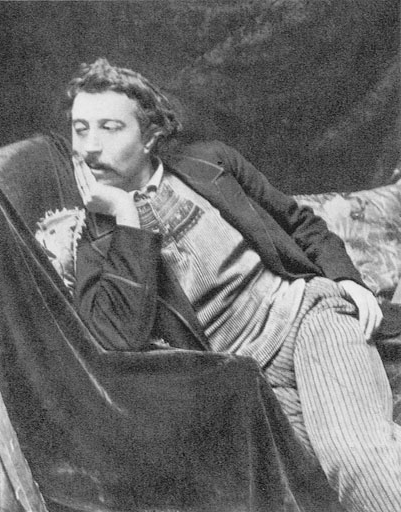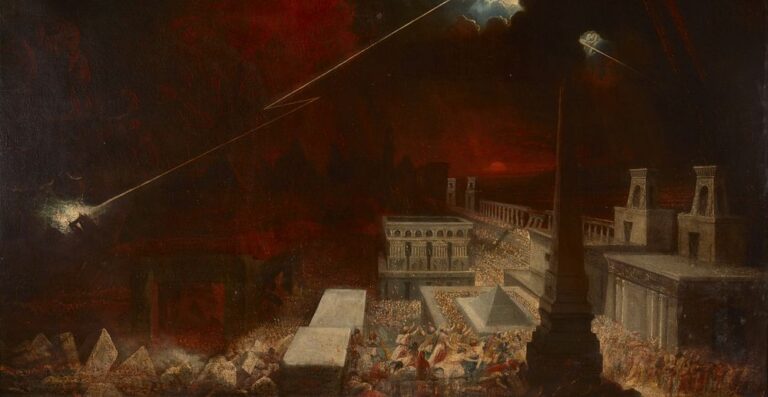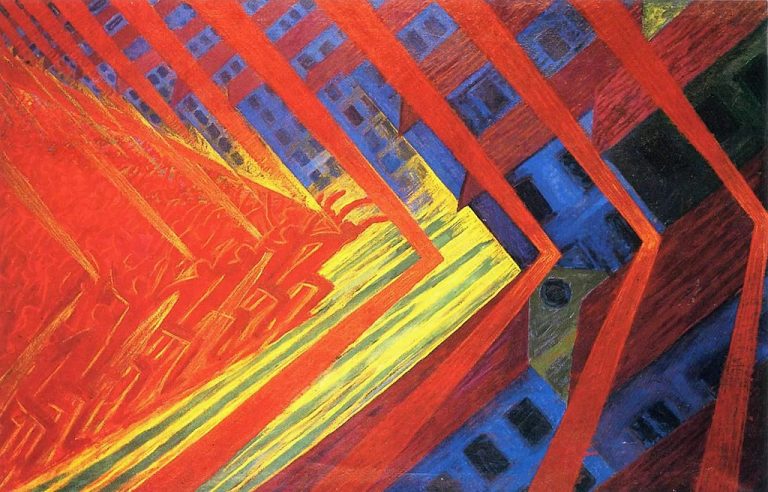Paul Gauguin Painter: Life and Legacy of the Post-Impressionist Master
Born: 7 June 1848, Paris, France
Death: 8 May 1903, Atuona, Marquesas Islands
Art Movement: Post-Impressionism, Primitivism, Symbolism
Nationality: French
Teacher: Self-Taught and Camille Pissarro
Institution: La Chapelle-Saint-Mesmin
Paul Gauguin Painter: Life and Legacy of the Post-Impressionist Master
Life and Career of Paul Gauguin
Paul Gauguin lived a remarkable life that took him from Europe to exotic locations in search of artistic inspiration. His journey from a stockbroker to a Post-Impressionist master represents one of the most fascinating transformations in art history.
Early Years and Education
Paul Gauguin was born in Paris on June 7, 1848, during a time of political upheaval in France. When he was only a year old, his family fled to Peru, where they lived for four years before returning to France. This early exposure to different cultures would later influence his artistic vision.
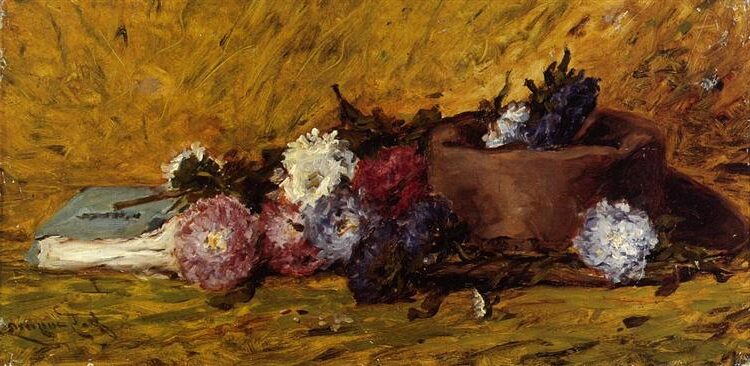
China Asters, Hat and Book, c.1876 – Paul Gauguin
As a young man, Gauguin received no formal art training. He joined the merchant marine at age 17 and later served in the French navy. These experiences exposed him to various parts of the world, broadening his perspective.
After his naval service, Gauguin worked as a stockbroker in Paris. During this period, he began collecting Impressionist paintings and experimenting with painting as a hobby. His early artistic efforts were largely self-taught, though he received some guidance from Camille Pissarro.
Initial Career and Family Life
In 1873, Gauguin married a Danish woman named Mette-Sophie Gad. They settled into a comfortable middle-class life in Paris and had five children together. His financial success allowed him to collect art and develop his own painting skills on weekends.
Gauguin exhibited his work with the Impressionists in 1881 and 1882. Though still an amateur, he showed promise as an artist. The stock market crash of 1882 dramatically reduced his income, pushing him to reconsider his career path.
As his interest in art grew, his commitment to family and conventional work declined. In 1884, Gauguin moved his family to Copenhagen, hoping to work as a tarpaulin salesman. When this failed, he returned to Paris alone in 1885, essentially abandoning his family to pursue art full-time.
First foray into Full-Time Art
Gauguin’s early years as a professional artist were marked by financial struggle and artistic experimentation. He spent time in Brittany, where he was drawn to the region’s traditional rural life and distinctive culture.

Working the Land, 1873 by Paul Gauguin
In 1886, he worked at the artist colony of Pont-Aven in Brittany. There, he developed his “Synthetist” style, characterized by bold colors, strong outlines, and simplified forms. This approach moved beyond Impressionism toward a more symbolic and abstract representation.
A pivotal moment came in 1888 when Gauguin joined Vincent van Gogh in Arles, France. Their relationship was productive but volatile, ending after two months when Van Gogh famously cut off part of his ear. Despite this dramatic conclusion, the period influenced both artists’ styles significantly.
Tahiti and Marquesas Islands Period
In 1891, Gauguin sailed to Tahiti, seeking escape from European civilization and “everything that is artificial and conventional.” He hoped to find an unspoiled paradise where he could create more primitive, authentic art.
The reality of colonial Tahiti disappointed him, yet he created some of his most famous works there. Paintings like “Where Do We Come From? What Are We? Where Are We Going?” showcase his distinctive use of bold colors and flattened forms to depict Polynesian subjects.
Gauguin returned to France in 1893 but went back to Tahiti in 1895. In 1901, seeking even greater isolation, he moved to the Marquesas Islands. His works from this period often romanticize native life while incorporating mystical and religious symbolism. His painting style became increasingly bold and experimental, using non-realistic colors and simplified forms.
Final Years and Death
Gauguin’s final years were marked by health problems, conflicts with local authorities, and continued artistic innovation. He suffered from syphilis and heart problems, which limited his physical abilities but not his creative output.

Arii Matamoe (The Royal End), 1892 by Paul Gauguin
He established a home he called “The House of Pleasure” and continued painting despite declining health. During this period, he also wrote and illustrated a manuscript combining poetry, observations, and artistic theories.
On May 8, 1903, Gauguin died in the Marquesas Islands at age 54. He died relatively unknown but left behind approximately 200 paintings, many sculptures, prints, and drawings. His bold experimentation with color and form would later influence major art movements of the 20th century, including Fauvism and Expressionism. Today, he is recognized as one of the most significant figures in modern art.
Artistic Style and Techniques
Paul Gauguin developed a distinctive artistic approach that broke from traditional European painting methods. His work combined bold colors, simplified forms, and influences from non-Western cultures to create a unique visual language that helped shape modern art.
Synthetism
Gauguin pioneered Synthetism alongside Émile Bernard in the late 1880s. This style emphasized flat areas of color, bold outlines, and simplified forms rather than realistic representation. Synthetism rejected the scientific approach of Impressionism and Neo-Impressionism in favor of expressing emotions and ideas through color and form.
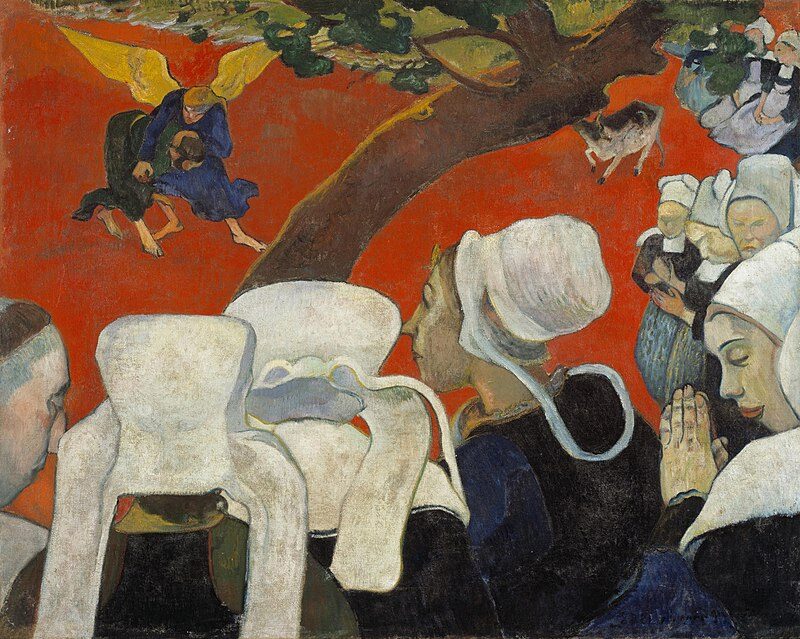
Vision After the Sermon (Jacob Wrestling with the Angel) (1888) – Paul Gauguin
In “Vision After the Sermon” (1888), Gauguin demonstrated key Synthetist principles with its flat red background, bold outlines, and simplified figures. He often eliminated shadows and perspective to create two-dimensional compositions.
Gauguin described his approach as painting “not what I see but what I feel.” This philosophy guided his work toward greater abstraction and symbolism, making him a forerunner of Expressionism and other modern art movements.
Use of Color
Gauguin employed color in radical ways that broke from traditional Western painting. He freed color from its descriptive purpose, using it instead to express emotions and spiritual ideas.
His palette featured bold, non-naturalistic colors—vibrant yellows, deep purples, and rich oranges. In Tahitian works like “Where Do We Come From? What Are We? Where Are We Going?” (1897), he used unnatural blues for water and unexpected greens for skin tones.
Gauguin applied paint in flat areas with minimal shading or modeling. He stated, “How do you see this tree? Is it green? Use green then, the most beautiful green on your palette. And that shadow, rather blue? Don’t be afraid to paint it as blue as possible.”
This revolutionary approach to color influenced the Fauves, particularly Henri Matisse, and helped establish color as an independent expressive element in modern art.
Woodcuts and Sculptures
Gauguin’s artistic innovation extended beyond painting to woodcuts and sculpture. His woodcuts blended Western techniques with influences from Japanese prints and Polynesian carvings.

The Universe is Created (L’Univers est créé), from the Noa Noa suite (1893–94)
In works like the “Noa Noa” series (1893-1894), he created rough-hewn images with bold, simplified forms. Rather than aiming for technical perfection, Gauguin embraced the raw quality of the medium.
His sculptural work included:
- Wooden carvings that referenced Polynesian and Marquesan art
- Ceramic pieces with primitive, mystical qualities
- Small-scale works in various materials
These three-dimensional creations showed the same rejection of Western academic traditions seen in his paintings. The deliberately crude execution and symbolic forms emphasized spiritual and emotional content over technical virtuosity.
Influence of Indigenous Art
Gauguin’s style was profoundly shaped by non-Western artistic traditions he encountered in Brittany, Martinique, Tahiti, and the Marquesas Islands.
He collected and studied indigenous artifacts, absorbing elements from Polynesian, Peruvian, and Egyptian art. From these sources, he adopted:
- Flattened perspective
- Symbolic rather than realistic representation
- Simplified, geometric forms
- Decorative patterns
In Tahiti, Gauguin incorporated local myths and symbols into works like “Mahana no Atua” (Day of the God, 1894). He didn’t merely copy indigenous styles but synthesized them with his European artistic background.
This cross-cultural approach was revolutionary but also controversial. Modern critics question his appropriation of indigenous cultures, while acknowledging how his embrace of non-Western aesthetics helped expand the boundaries of Western art.
Major Works and Legacy
Paul Gauguin created influential paintings that changed the course of modern art through bold colors and simplified forms. His work continues to impact artists today and remains celebrated in major museums worldwide.
Notable Paintings
Gauguin’s most famous work is “Where Do We Come From? What Are We? Where Are We Going?” (1897-98), a large philosophical painting created in Tahiti. This masterpiece explores themes of human existence through vibrant colors and symbolic figures.
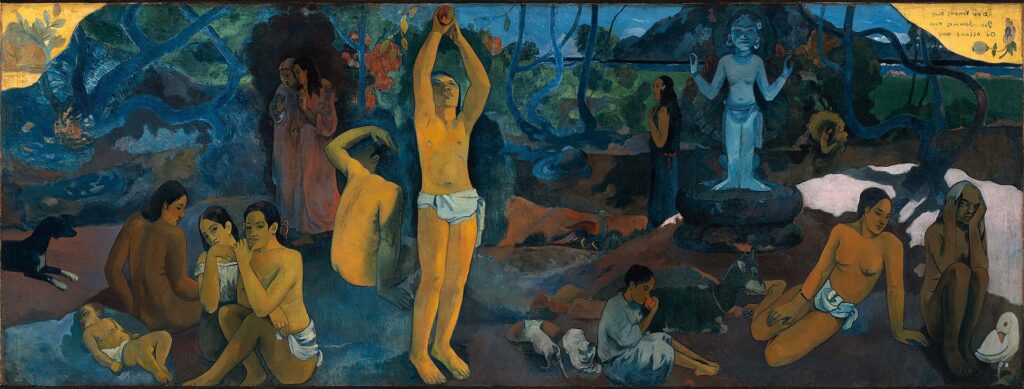
Where Do We Come From? What Are We? Where Are We Going? (1897) – Paul Gauguin
“Vision After the Sermon” (1888) marks a critical turning point in his career. The painting features bold red fields and simplified forms that broke from Impressionism’s naturalistic approach.
Other significant works include “The Yellow Christ” (1889), “Ia Orana Maria” (1891), and “Nevermore” (1897). Each painting demonstrates his distinctive style of flat areas of color, little shadow, and strong outlines.
Gauguin’s Tahitian paintings like “Two Tahitian Women” (1899) remain his most recognizable works, featuring native subjects in natural settings with vibrant, non-naturalistic colors.
Impact on Post-Impressionism
Gauguin helped define Post-Impressionism by rejecting the naturalism of Impressionism in favor of more symbolic and emotional approaches. His use of non-naturalistic color and simplified forms influenced generations of artists.

Change of Residence, 1899 by Paul Gauguin
His brief but important collaboration with Vincent van Gogh in Arles (1888) proved significant for both artists’ development. Their exchanges pushed each toward more expressive and symbolic styles.
Gauguin’s emphasis on emotional and spiritual content rather than visual accuracy helped shift art toward greater abstraction. This approach directly influenced movements like Fauvism and Expressionism.
His technique of using broad, flat areas of color with strong outlines (known as “cloisonnism”) provided a foundation for modern approaches to painting. Artists like Pablo Picasso and Henri Matisse studied his techniques closely.
Contribution to Primitivism
Gauguin pioneered artistic “primitivism” through his escape to Tahiti and immersion in non-Western cultures. He sought what he considered more authentic and spiritually pure ways of life away from European industrialization.
His paintings featuring Tahitian people and landscapes presented an idealized view of indigenous life. These works combined observed reality with imagination and Western artistic traditions.
Critics now recognize the problematic aspects of his colonial gaze and romanticized portrayals of Polynesian subjects. His work raises important questions about cultural appropriation and representation.
Despite these controversies, Gauguin’s engagement with non-Western visual traditions helped expand the visual language of Western art. His work encouraged artists to look beyond European traditions for inspiration and techniques.
Reception and Critical Acclaim
During his lifetime, Gauguin received mixed responses from critics and limited commercial success. Many viewers found his bold style and subject matter too radical for contemporary tastes.
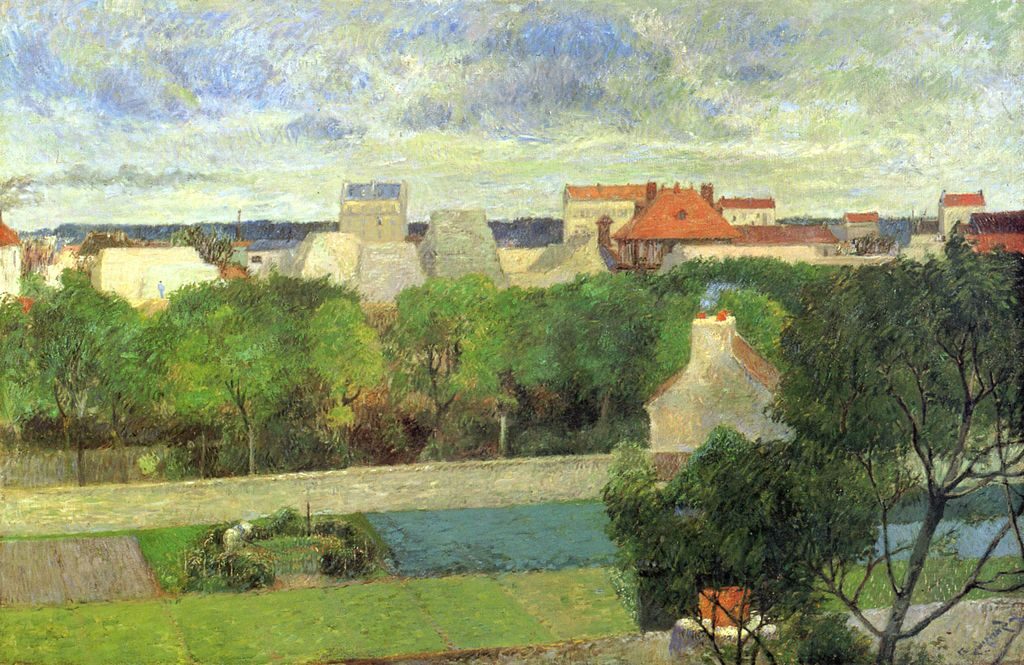
The Market Gardens of Vaugirard, 1879 by Paul Gauguin
After his death in 1903, his reputation grew substantially. A major posthumous exhibition in Paris in 1906 introduced his work to younger artists and solidified his importance in art history.
Today, Gauguin’s paintings command some of the highest prices in the art market. His “When Will You Marry?” sold for approximately $300 million in 2015, making it one of the most expensive paintings ever sold.
Museum exhibitions of Gauguin’s work continue to draw large crowds worldwide. Curators now present his art alongside critical discussions of colonialism and his relationships with Tahitian women, offering more nuanced views of his legacy.
Frequently Asked Questions
Paul Gauguin’s distinctive artistic style and turbulent life story continue to fascinate art enthusiasts worldwide. His bold color choices, simplified forms, and cultural influences shaped modern art in profound ways.
What are the distinguishing characteristics of Paul Gauguin’s painting style?
Gauguin’s style features bold, flat areas of color with strong outlines. He rejected realistic perspective and shading in favor of more symbolic approaches.
His paintings often contain simplified forms and unusual color choices that convey emotion rather than reality. This approach became known as Synthetism.
Gauguin frequently incorporated decorative elements and patterns inspired by non-Western art, particularly Polynesian motifs. His compositions tend to be flattened with minimal depth.
How did Paul Gauguin’s time in Tahiti influence his art?
Gauguin first traveled to Tahiti in 1891, seeking what he considered a more “primitive” and authentic way of life. The vibrant tropical environment transformed his palette to include more brilliant yellows, oranges, and pinks.
Polynesian culture provided Gauguin with new subject matter, including local people, landscapes, and spiritual themes. He integrated Tahitian symbols and myths into his work, creating a unique fusion of European and Polynesian artistic traditions.
The isolation allowed Gauguin to develop his distinctive style away from European influences. His Tahitian paintings reflect his idealized view of island life rather than a realistic portrayal.
What impact did Paul Gauguin have on the Post-Impressionist movement?
Gauguin helped define Post-Impressionism by moving beyond Impressionism’s focus on light and momentary effects. He prioritized expression, symbolism, and emotional content over visual accuracy.
His innovative use of color and form influenced many artists, including the Fauves and Expressionists. Henri Matisse and Pablo Picasso both acknowledged Gauguin’s significant impact on their work.
Gauguin’s interest in non-Western art forms helped legitimize these influences in European art circles. This opened doors for later artists to explore diverse cultural aesthetics.
Can you describe the evolution of Paul Gauguin’s artistic career?
Gauguin began as a Sunday painter while working as a successful stockbroker in Paris. After the stock market crashed in 1882, he committed to painting full-time.
He initially painted in an Impressionist style, influenced by his mentor Camille Pissarro. By the late 1880s, Gauguin developed his own approach while working in Brittany and Martinique.
His style became more symbolic and abstract after moving to Tahiti in 1891. His final years in the Marquesas Islands saw him create some of his most powerful works before his death in 1903.
What are some of the most famous works created by Paul Gauguin, and where can they be viewed?
“Vision After the Sermon” (1888) shows Breton women witnessing Jacob wrestling with an angel and is housed in the National Gallery of Scotland. “The Yellow Christ” (1889), featuring a crucifixion scene in Brittany, can be found at the Albright-Knox Art Gallery in Buffalo.
“Where Do We Come From? What Are We? Where Are We Going?” (1897-98), Gauguin’s masterpiece addressing human existence, is displayed at the Museum of Fine Arts in Boston.
“Ia Orana Maria” (1891), depicting a Tahitian Madonna and Child, is at the Metropolitan Museum of Art in New York.
“Two Tahitian Women” (1899) resides in the Metropolitan Museum of Art, while “Nevermore” (1897), showing a reclining Tahitian woman, is in London’s Courtauld Gallery.
How did Paul Gauguin’s personal life and views shape his approach to painting?
Gauguin’s rejection of conventional society influenced his artistic choices. He abandoned his career and family in France to pursue art. This reflects his willingness to break social norms.
His complex relationships with women and controversial views on colonialism appear throughout his work. His paintings often depict Tahitian women in ways that reflect his own fantasies and colonial perspective.
Gauguin’s spiritual interests and fascination with “primitive” cultures drove his artistic exploration. He combined Catholic imagery with Polynesian mythology. This created a personal symbolic language that defied traditional European art.


